WHO'S IN A NAME?
People Commemorated in Eastern Sierra Plant Names
Return to Index
Twinberry Honeysuckle, Lonicera involucrata (Richardson) Banks (Caprifoliaceae)
by Larry Blakely
References and Notes
(First Posted: 2004 09 20; Text appeared in the newsletter of the Bristlecone chapter, CNPS, September, 2004/Vol. 24, No. 5)

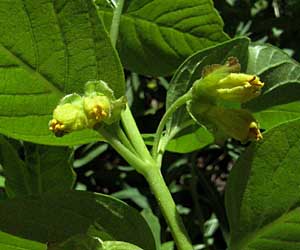
Twinberry Honeysuckle, Lonicera involucrata (Richardson) Banks var. involucrata. Photos and © by Larry Blakely (2004)
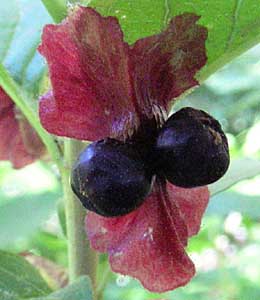
Blakely Photo 2004
I first encountered this delicate and lovely native shrub a decade ago, at 9100 feet elevation along Mammoth Creek, near the entrance to the Mammoth Consolidated Mine ghost camp. I learned then, from my year-old Jepson Manual, that it grows over much of North America. I did not react at that time to "Banks", the namer. (This plant, which ranges over much of North America, is usually designated var. involucrata to distinguish it from a variety of limited range, var. ledebourii, which occurs in coastal regions of northern California and southern Oregon)
This little essay started out to be a book review of a biography of Joseph Banks (1743-1820) (1), a botanist of considerable historical interest for botanical science. But then I happened to rediscover the nomenclatural connection between Sir Joseph and the Eastern Sierra, in the form of this species of honeysuckle, which indeed was named by him. I thus decided to switch genres. By the way, the 1987 biography, Joseph Banks: A Life, by Patrick O'Brian, is a remarkably enjoyable read. O'Brian is the brilliant author of the Master and Commander series of 'tall ship' sailing novels set in the time of Banks' life.

Joseph Banks in 1773, protrait by Joshua Reynolds (source)
Though this essay is about Banks, let it be noted that the genus Lonicera was named for German herbalist Adam Lonitzer (1528-1586), by Linnaeus. Mention will be made below of Richardson (and a few other historical figures). The rest of the scientific name is accounted for by an involucre which expands and reddens in fruit, highlighting the pair of dark purple berries.
Joseph Banks inherited considerable wealth while quite young, his father having died when he was 18. A prodigious income and extensive properties became his when he turned 21. Some young men in those circumstances might have become self-indulgent and profligate, but Joseph, throughout his long life, not only used his fortune in numerous worthy pursuits, but, by good management, actually increased his wealth. And he became a giant in the history of modern botany.
A lifelong passionate interest in botany began at age 14. With his wealth and considerable influence, he became a major player, largely by supporting and fostering the careers of others, in those heady decades of botanical exploration which occurred during the latter half of the 18th and first half of the 19th centuries. Especially with regard to botanical exploration, think: Linnaeus, then Banks, then Everybody Else. Generally, Banks left to others the naming of the great many plants he collected, or whose collection he fostered.
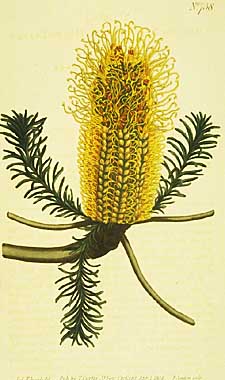
Banksia ericaefolia L.f., Plate no. 738, Curtis Botanical Magazine, 1804 (2)
He personally engaged in worldwide exploration in his early adulthood. His greatest achievement, which firmly established his reputation, was the role he so successfully played as chief naturalist aboard the Endeavour, on the first round-the-world voyage commanded by Captain James Cook, during the years 1768-1771. You can join the members of that remarkable expedition, vicariously that is, through the medium of Banks' journal, made available in its entirety by an Australian government website. The Australian connection is understandable, as that voyage resulted in the rediscovery and early mapping of the island continent. Major botanical discoveries came during a stop at what Cook named 'Botany Bay'. (It was Banks who later promoted Botany Bay as a destination for transportation of criminals.) The genus name Banksia was coined by Linnaeus' son for an unusual plant Banks collected there.
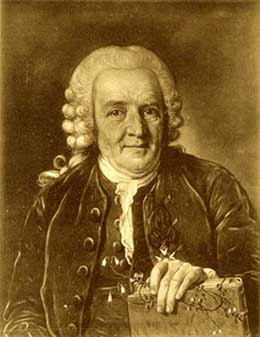
Carl Linnaeus (1707-1778) (3)
Linnaeus himself sang Banks' praises to the highest degree, and regretted that his age would probably prevent him from seeing the publication of Banks' collections. He proclaimed Banks an immortal - having seen more plant species than any earlier botanist. Many of Linnaeus' students were among the first botanical explorers. Daniel Solander, who accompanied Banks on the Endeavour, was one of Linnaeus’ students. Solander became Banks' right hand man, and continued to serve him for many years after the return of the Endeavour.
David Nelson was a 'gardener' (sort of an apprentice botanist at that time) at Kew when Banks urged Cook to take him along as botanist on Cook's fatal (for Cook) third voyage of discovery. Banks later included him as botanist among the company he assembled for a mission to Tahiti to collect breadfruit seedlings, employing the ship the Bounty, commanded by another of those he helped professionally, William Bligh. Nelson stayed with Bligh after the famous mutiny, and, though he survived the thousands of miles in an open boat, tragically died not long after safe harbor was reached. Banks later secured the governorship of an Australian province for Bligh. (Bligh's story was briefly noted in another of these essays, the one on Layia glandulosa.)(4)
One of Banks' more famous proteges, as least insofar as North American botany goes, was the Scottish botanist Archibald Menzies. He was botanist on two voyages from England, around the Horn, to the shores of western North America, where he made extensive collections. Many California plants bear his name, most famously the Douglas fir, Pseudotsuga menziesii, (5) collected in 1792 during the voyage of Captain Vancouver. Menzies' journal and his extensive correspondence with Banks make fascinating historical reading. Thanks to the wonders of the world wide web, they are now, at least in part, easily available for all to read. (6)
With Banks' botanical fame spread far and wide, it was no wonder that he had many supplicants for help in finding botanical employment. He told one of them that botany was the most unprofitable trade he knew, but the brave young fellow was not to be deterred, and Banks found him a job.
Banks' fame and influence garnered him the presidency of the prestigious Royal Society, England's major scientific society, in 1778, a post he held until his death 42 years later. He had been a member since before the voyage of the Endeavour. Membership in the Royal Society was aspired to by all scientists of the time. (This remains so even now; among all the letters following his name, my professor at Cornell was proudest of his FRS, 'Fellow of the Royal Society'.) No saintly dandies, these top luminaries of science; an eyewitness account of one of their meetings, given by a visiting European scientist ca. 1780, has principal members, including Banks who presided, and their guests, sharing a pre-meeting feast featuring multiple courses of variously cooked beef, lamb, and vegetables washed down with numerous rounds of strong beer, wine (everyone present, along with absent notables, had to be individually toasted), champagne, and brandy, capping off the meal with several cups of both tea and coffee. At the following meeting, the visitor noted, "We were all pretty much enlivened but our gaiety was decorous."
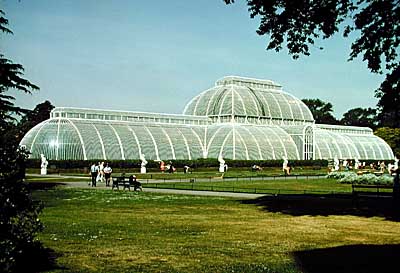
The Palm House at Kew Gardens
(Blakely photo, 1975)
Another of Banks' many botanical accomplishments was the establishment of the famous Royal Botanic Gardens at Kew, near London. This was accomplished in partnership with his friend King George III - yes, one and the same as the nemesis of the embryonic USA. The King had his good and bad points, and times, like everybody else. During bad times - sometimes a result of periodic mental health lapses - he even turned the genial Banks off. It was during good times that he and Banks planned and developed the national botanical treasury of dried and living specimens, garnered from explorations all over the world.
Banks was a supporter and mentor of international science, thoroughly apolitical in times of European upheaval. He was a friend of Ben Franklin before and after the Revolutionary War, and of French scientists during the Napoleonic Wars. Franklin was in England for several years prior to the Revolutionary War, and one day, ca. 1773, he (nearly 70) and Banks (about 30), accompanied by Solander, got together to carry out a field experiment to test one of Franklin's theories. (7) Franklin had been elected to membership in the Royal Society in 1756, in recognition of his experiments on electricity. Later, when peace had been established between England and the US, Franklin, still in France, reported to Banks on the first hot-air balloon flights. (8) In one of his replies, Banks apologized for "the illiberal treatment towards you, with which I fear this country may too justly be accused." Franklin had instructed the US government, during the Revolutionary War, not to interfere with the scientific voyages of Captain Cook, a gesture for which Franklin was honored, in 1784, by the English; had he not left England in 1774, to evade an arrest warrant, the same English probably would have hanged him then. (9)
* * *
A year prior to leaving with Cook aboard the Endeavour, Banks sailed to Labrador and Newfoundland, where he did his first serious collecting on foreign shores. That was to be his only direct contact with North America, but he did not collect the honeysuckle on that trip. So how did he come to name Lonicera involucrata? Following is the story, with the facts and some conjecture.

Richardson's party traveled overland for thousands of miles, by canoe (with frequent portages) up and down rivers and across lakes, by doglsed, and on foot. Richardson collected a large number of new plant species on this trip, many of which were named for or by him.
(Public Domain graphic, 10)
English naturalist John Richardson (1787-1865; the 'Richardson' in the full name of the plant) traveled with John Franklin, leader of an eventually disastrous expedition (their hair-raising journal is online) to explore the North American shores of the Arctic Ocean, during the years 1819-1822. They arrived, by ship, from England at York Factory on Hudson Bay on August 30, 1819, and left to proceed overland on September 19. Richardson's notes say he collected the honeysuckle in "wooded country between 54 and 64 degrees latitude", but exactly when and where is, apparently, not recorded. Prior to arriving at York Factory their ship made a landfall for fresh water after entering Hudson Strait; both Richardson and Franklin eagerly explored the shore, and Richardson collected specimens of thirty plant species. It seems most likely that the honeysuckle was among this collection, which could then have been taken back to England - and Kew Gardens - by the Hudson's Bay Company supply ship Prince of Wales, the ship which dropped the explorers off at York Factory. (11)
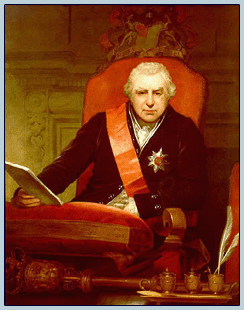
Banks in the regalia of President of the Royal Society (Source)
Banks was in ill health during much of the latter part of his life, and he was so incapacitated by gout and other ailments during the last year of his life that he asked to be relieved of the Royal Society presidency. But his colleagues would have none of it, and he withdrew the request in a letter written about three weeks before his death, which came on June 19, 1820. It seems clear from his involvement with the honeysuckle that even in his poor health he retained the ardor he had held over his entire adult life for arrivals of new plant specimens from distant shores. Somehow he managed to examine Richardson's shipment; he either forced himself to go see it at Kew, or perhaps had it sent to his home.
In 1823 Richardson published names for many of the new species among his extensive North American collections, and gave the name Xylosteon involucratum to the honeysuckle. (12) But when Banks was examining Richardson's early specimens, in late 1819 or early 1820, and came to the honeysuckle, perhaps he wrote "Lonicera" on the herbarium sheet, or in some other way made it be known what genus he thought it belonged to. Whatever the circumstances, Banks' name Lonicera involucrata did not appear in a publication until 1825, 5 years after his death. Richardson is recognized for first naming the plant and coining the specific epithet, but he assigned it to a genus whose members were not long after transferred to Lonicera. Banks is recognized as the one first responsible for assigning it to the proper genus. Thus the scientific name by which the pretty shrub, widespread in Nature, including the Eastern Sierra, and widely cultivated, came into being.
REFERENCES and NOTES
1. O'Brian, Patrick. 1987. Joseph Banks: A Life. University of Chicago Press edition, 1997. 328 pp. Many of the unattributed facts in this essay may be found in this well researched book. Many thanks to friend Bob Wicks for putting me on to O'Brian.
2. From the website http://www.nal.usda.gov/curtis/heathleb.shtml [broken link - you can find a pdf of the book - volumes 19-20 of Curtis's Botanical Magazine, archived here: curtis_botanical_mag_vol_19_20.pdf (scroll to page 84 of the pdf / page 738 of the book)]. The text accompanying the illustration reads as follows:
The Banksia, a genus so named in honour of its first discoverer, the President of the Royal Society, in a voyage round the world with Captain Cook, is very nearly allied to Protea, and like that appears to contain a great number of species of very various forms and size. Our present plant forms a handsome shrub, thrives freely, and has flowered in several collections ; our drawing was taken from that of E. J. A. Woodford, Esq. at Vauxhall, in April 1802.
The beauty of the flower consists very much in the length of the style; which, from the stigma being long retained within the anthers, is fancifully bent into a loop: when the efflorescence is complete, the petals expand and let the stigma at liberty. The flower is considered by some as monopetalous, but the petals, in BANKSIA ericaefolia at least, adhere so slightly at the base only, that they can hardly be kept from separating when removed from the receptacle. The germen in this species is surrounded with brown hairs very like that of many of the Proteae. We could not discover any other calyx than the squama of the Amentum, in no respect like that described by Gaertner. A native of New-Holland. By no means tender, and may be kept in a greenhouse with Proteas and other Cape shrubs. Propagated by seeds and by cuttings.
3. From an article on Linnaeus by Louise Petrusson, Swedish Museum of Natural History website.
4. A recent website (http://www.plantexplorers.com/Explorers/Biographies/Captain/Bligh.htm) on Bligh provides a rather different picture of the captain from that given by most sources, calling him "Arguably one of the most misunderstood and complex characters in maritime history." It is suggested that the mutiny, portrayed in no less than three commercial movies, was more a result of resentment among his men at being made to leave Tahiti, than over any ill-treatment by Bligh.
5. The beautiful Madrone was also first collected by Menzies, and given the name Arbutus menziesii by Frederick Pursh in his Flora Americae Septentrionalis of 1814 . The stately Mountain Dogwood was another among plants collected by Menzies in 1792 (he called it "the great flowered Dog wood"), but it was considered by authorities at the time to be the same as the Flowering Dogwood, Cornus florida L., of Eastern North America. Had it been recognized as new, it might today be called "Cornus menziesii". (It was left to Thomas Nuttall, who collected specimens on his western trip of the 1830s, to claim it to be a different species. J. J. Audubon named it in Nuttall's honor, Cornus nuttallii, in his great work on the Birds of America; the name first appeared in a botanical publication, Torrey and Gray's Flora of North America, 1838-1843.)
6. An extract of Menzies' lengthy journal is at www.americanjourneys.org/aj-110/. The extract chronicles, in depth, the exploration of the coasts and waters of northwest Washington State, southwest British Columbia, and Vancouver Island. Much of the detailed exploration was done by a Leutenant Puget and a Mr. Whidbey. Menzies collected whenever he could get ashore; he also reported on the native peoples. North of the San Juan Islands they encountered many Natives who lived in plank houses, decorated with paintings, as were their canoes. With a touch of hubris, Menzies wrote:
We passed some small Villages on the Southern shore but had no intercourse with any of the Natives, which we supposd might proceed from their shyness or the panic with which they might be struck at seeing two large Vessels traversing their Channel to Windward with so much apparent ease & moving in every direction so obedient to our will with such mechanical powers as they could have no idea of, & must no doubt afford to their uncultivated minds a subject of the utmost admiration & astonishment.
7. Van Doren, Carl. 1938. Benjamin Franklin. Viking Press, New York. p. 435.
8. In 1783 Franklin wrote, from France, the following much quoted letter to Banks, in England:
Dear Sir;
I received your very kind letter by Dr. Blagden, and esteem myself much honoured by your friendly Remembrance. I have been too much and too closely engaged in public Affairs, since his being here, to enjoy all the Benefit of his Conversation you were so good as to intend me. I hope soon to have more Leisure, and to spend a part of it in those Studies, that are much more agreeable to me than political Operations.
I join with you most cordially in rejoicing at the return of Peace. I hope it will be lasting, and that Mankind will at length, as they call themselves reasonable Creatures, have Reason and Sense enough to settle their Differences without cutting Throats; for, in my opinion, there never was a good War, or a bad Peace. What vast additions to the Conveniences and Comforts of Living might Mankind have acquired, if the Money spent in Wars had been employed in Works of public utility! What an extension of Agriculture, even to the Tops of our Mountains; what Rivers rendered navigable, or joined by Canals: what Bridges, Aqueducts, new Roads, and other public Works, Edifices, and Improvements, rendering England a compleat Paradise, might have been obtained by spending those Millions in doing good, which in the last War have been spent in doing Mischief; in bringing Misery into thousands of Families, and destroying the Lives of so many thousands of working people, who might have performed the useful labour!
I am pleased with the late astronomical Discoveries made by our Society. Furnished as all Europe now is with Academies of Science, with nice Instruments and the Spirit of Experiment, the progress of human knowledge will be rapid, and discoveries made, of which we have at present no Conception. I begin to be almost sorry I was born so soon, since I cannot have the happiness of knowing what will be known 100 years hence.
I wish continued success to the Labours of the Royal Society, and that you may long adorn their Chair; being, with the highest esteem, dear Sir, &c.,
B. Franklin
P.S. Dr. Blagden will acquaint you with the experiment of a vast Globe sent up into the Air, much talked of here, and which, if prosecuted, may furnish means of new knowledge.
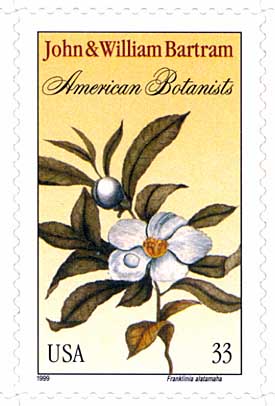
9. Franklin was also honored in the botanical realm by his friend, American botanist John Bartram, who named a southern tree, which he discovered in Georgia, Franklinia alatamaha. Though now extirpated in nature, it lives on in many gardens, and was featured on a US postage stamp of recent vintage.
10. Fall at the third portage above Ka-Ka-Beko. A Journey from the Prince of Wales's Fort in Hudson's Bay to the Northern Ocean : Undertaken by order of the Hudson's Bay Company, for the discovery of copper mines, a Northwest Passage &c in the Years 1769, 1770, 1771 and 1772; Samuel Hearne. London: Printed for A. Strahan and T. Cadell, 1795. Source: National Library of Canada © Public Domain
11. It is also possible that the honeysuckle could have been collected near York Factory, or even during the party's travels inland. In the latter case, the specimens would have had to be sent back overland to York Factory, and, in order for Banks to have seen the honeysuckle specimen(s), it (they) would have had to reach England before Banks death in June, 1820.
Journals by both Richardson and Franklin have been published, as well as a journal by another party member.
- Franklin, John. 1823. Narrative of a Journey to the Shores of the Polar Sea in the Years 1819, 20, 21, and 22. Murray, London. (Much of this was actually written by Richardson and other members of the party. The 2000 edition by Brassay's Inc, Washington, D.C., has two excellent introductions. The original is online here.)
- Houston, C. Stuart. 1984. Arctic Ordeal. The Journal of John Richardson, Surgeon-naturalist with Franklin, 1820-1822. McGill-Queen's Univ. Press, Montreal.
- Houston, C. Stuart. 1974. To the Arctic by Canoe, 1819-21. The Journal and Paintings of Robert Hood, Midshipman with Franklin. McGill-Queen's Univ. Press, Montreal.
12. The naming history of Lonicera involucrata (Richardson) Banks can be gleaned from the sources listed below (there are of course other sources). In some cases, Richardson's name is given as Xylosteum involucratum, but most give the genus name as Xylosteon. I have not seen Richardson's original description, which appeared in an appendix to Franklin's journal (11). That appendix does not appear in more recent reprints of Franklin's journal, nor is it included in the on-line version.
- Torrey, John, and Gray, Asa. 1838-43. A Flora of North America. Vol. II, p. 9.
- Abrams, Leroy and Ferris, Roxana. 1960. Illustrated Flora of the Pacific States. Vol IV, p. 52.
- Cronquist, Arthur, et al. 1984. Intermountain Flora. Vol. 4, p. 540.
- IPNI, International Plant Name Index
- ING, Index Nominum Genericorum